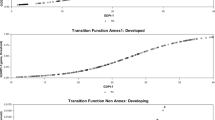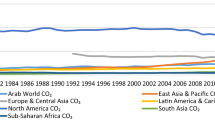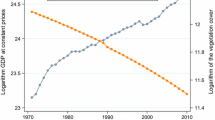Abstract
In the presence of more than one scenario on the interaction of growth, environmental regulation and environmental quality, it is unclear what shape is assumed by the relation between environmental degradation and income per capita (that is, the environmental Kuznets curve). Evidence based on Australian data is presented, suggesting that the environmental Kuznets curve EKC is valid for carbon dioxide, in the sense that an inverted U-shaped curve is observed for several measures of CO2 emissions. The results, however, cannot be generalized because the relation between environmental degradation and income per capita is time-varying and country-specific. It also depends on how environmental degradation and income per capita are measured.
Access this chapter
Tax calculation will be finalised at checkout
Purchases are for personal use only
Similar content being viewed by others
Notes
- 1.
Conversely, environmental quality is a U-shaped function of income per capita. The convention is to consider the dependent variable to be environmental degradation (as indicated, for example, by the level of a pollutant) rather than environmental quality.
- 2.
The origin of the KEC can be traced back to the original Kuznets curve. At the sixty-seventh annual meeting of the American Economic Association in December 1954, Simon Kuznets delivered a presidential address on economic growth and income inequality. He suggested that rising per capita income is conducive to rising income inequality up to a certain point after which inequality declines with rising income (Kuznets 1955). Kuznets believed that the distribution of income becomes more unequal at early stages of income growth but it eventually moves towards more equality as growth continues. This changing relation between per capita income and income inequality can be represented by an inverted U-shaped curve.
- 3.
The demand for environmental quality may rise more than proportionately if the income elasticity of demand for environmental quality is greater than one.
- 4.
This argument does not invalidate the EKC if environmental degradation is measured in terms of pollution per capita or per dollar of output.
References
Anjum, Z., Burke, P. J., Gerlagh, R., & Stern, D. I. (2014). Modeling the Emissions-Income Relationship Using Long-Run Growth Rates (CCEP Working Papers No. 1403). Canberra: The Australian National University.
Beckerman, W. (1992). Economic Growth and the Environment: Whose Growth? Whose Environment? World Development, 20, 481–496.
Chow, G. C., & Li, J. (2014). Environmental Kuznets Curve: Conclusive Econometric Evidence for CO2. Pacific Economic Review, 19, 1–7.
Daly, H. (1991). Steady-State Economics (2nd ed.). Washington, DC: Island Press.
Dasgupta, S., Laplante, B., Wang, H., & Wheeler, D. (2002). Confronting the Environmental Kuznets Curve. Journal of Economic Perspectives, 16, 147–168.
Esty, D. C., & Porter, M. E. (2002). Ranking National Environmental Regulation and Performance: A Leading Indicator of Future Competitiveness? In World Economic Forum (Ed.), Global Competitiveness Report 2001–2002. New York: Oxford University Press.
Grossman, G. M., & Krueger, A. B. (1991). Environmental Impacts of a North American Free Trade Agreement (NBER Working Papers No. 3914). Cambridge, MA: National Bureau of Economic Research.
Grossman, G. M., & Krueger, A. B. (1993). Pollution and Growth: What Do We Know? In I. Goldin & L. Winters (Eds.), The Economics of Sustainable Development. Cambridge, MA: MIT Press.
Grossman, G. M., & Krueger, A. B. (1995). Economic Growth and the Environment. Quarterly Journal of Economics, 110, 353–377.
Jänicke, M., Binder, M., & Mönch, H. (1997). Dirty Industries: Patterns of Change in Industrial Countries. Environmental and Resource Economics, 9, 467–491.
Kriström, B., & Riera, P. (1996). Is the Income Elasticity of Environmental Improvements Less Than One? Environmental and Resource Economics, 7, 45–55.
Kuznets, S. (1955). Economic Growth and Income Inequality. American Economic Review, 49, 1–28.
Levinson, A. (2000). The Ups and Downs of the Environmental Kuznets Curve. The UCF/CentER Conference on Environment, November 30–December 2, 2000, Orlando. https://core.ac.uk/download/files/153/6589463.pdf
Lim, J. (1997). Economic Growth and Environment: Some Empirical Evidences from South Korea (Working Paper). Sydney: University of New South Wales, School of Economics.
Lopez, R. (Ed.). (1992). The Environment as a Factor of Production: The Economic Growth and Trade Policy Linkages. Washington, DC: World Bank.
Martinez-Alier, J. (1995). The Environment as a Luxury Good or “Too Poor to Be Green”? Ecological Economics, 13, 1–10.
Millimet, D. L., List, J. A., & Stengos, T. (2003). The Environmental Kuznets Curve: Real Progress or Misspecified Models? Review of Economics and Statistics, 85, 1038–1047.
Neumayer, E. (2003). Weak Versus Strong Sustainability. Cheltenham: Edward Elgar.
Panayotou, T. (1993). Empirical Tests and Policy Analysis of Environmental Degradation at Different Stages of Economic Development (ILO Technology and Employment Programme Working Papers No. WP238). Geneva: International Labour Organization.
Panayotou, T. (1997). Demystifying the Environmental Kuznets Curve: Turning a Black Box into a Policy Tool. Environment and Development Economics, 2, 465–484.
Panayotou, T. (2000). Economic Growth and the Environment (CID Working Papers No. 56). Cambridge, MA: Harvard University
Perman, R., & Stern, D. I. (2003). Evidence from Panel Unit Root and Cointegration Tests that the Environmental Kuznets Curve Does Not Exist. Australian Journal of Agricultural and Resource Economics, 47, 325–347.
Selden, T., & Song, D. (1994). Environmental Quality and Development: Is There a Kuznets Curve for Air Pollution Emissions? Journal of Environmental Economics and Management, 27, 147–162.
Shafik, N., & Bandyopadhyay, S. (1992). Economic Growth and Environmental Quality: Time Series and Cross-Country Evidence, Background Paper for the World Development Report 1992. Washington, DC: The World Bank.
Stern, D. I. (2004). The Rise and Fall of the Environmental Kuznets Curve. World Development, 32, 1419–1439.
Stern, D. I. (2010). Between Estimates of the Emissions-Income Elasticity. Ecological Economics, 69, 2173–2182.
Stern, D. I. (2014). The Environmental Kuznets Curve: A Primer (Crawford School of Public Policy Working Paper No. 1404). Canberra: The Australian National University.
Suri, V., & Chapman, D. (1998). Economic Growth, Trade and the Energy: Implications for the Environmental Kuznets Curve. Ecological Economics, 25, 195–208.
Torras, M., & Boyce, J. K. (1998). Income, Inequality, and Pollution: A Reassessment of the Environmental Kuznets Curve. Ecological Economics, 25, 147–160.
Vollebergh, H. R. J., Melenberg, B., & Dijkgraaf, E. (2009). Identifying Reduced-Form Relations with Panel Data: The Case of Pollution and Income. Journal of Environmental Economics and Management, 58, 27–42.
World Bank. (1992). World Development Report 1992: Development and the Environment. New York: Oxford University Press.
Yandle, B., Vijayaraghavan, M., & Bhattarai, M. (2000). The Environmental Kuznets Curve: A Primer. The Property and Environment Research Center. http://www.perc.org/articles/environmental-kuznets-curve
Zhang, J. (2012, September). Delivering Environmentally Sustainable Economic Growth: The Case of China (Working Paper). New York: Asia Society.
Author information
Authors and Affiliations
Editor information
Editors and Affiliations
Appendix
Appendix
Rights and permissions
Copyright information
© 2017 The Author(s)
About this chapter
Cite this chapter
Moosa, I.A. (2017). Economic Growth as a Cause of Environmental Degradation: The Australian Experience. In: Banik, A., Barai, M., Suzuki, Y. (eds) Towards A Common Future. Palgrave Macmillan, Singapore. https://doi.org/10.1007/978-981-10-5592-8_12
Download citation
DOI: https://doi.org/10.1007/978-981-10-5592-8_12
Published:
Publisher Name: Palgrave Macmillan, Singapore
Print ISBN: 978-981-10-5591-1
Online ISBN: 978-981-10-5592-8
eBook Packages: Economics and FinanceEconomics and Finance (R0)

















